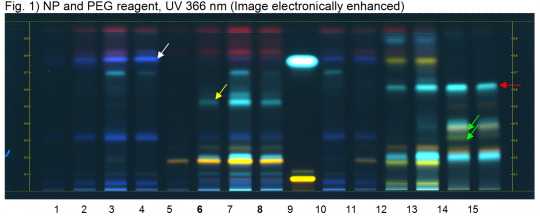Foeniculum vulgare (fruit)
(Nomenclature updated) |
(Various title corrections, Source additions) |
||
| Line 1: | Line 1: | ||
| + | {{DISPLAYTITLE:''Foeniculum vulgare'' (fruit) }} | ||
| + | |||
=Nomenclature= | =Nomenclature= | ||
| Line 11: | Line 13: | ||
|notes= }} | |notes= }} | ||
| − | = | + | =Botanical Voucher Specimen= |
| + | =Organoleptic Characteristics= | ||
| + | =Macroscopic Characteristics= | ||
{{Macroscopy | source=United States Dispensatory (1918) | {{Macroscopy | source=United States Dispensatory (1918) | ||
| description=Fennel Fruit is the ripe fruit of | | description=Fennel Fruit is the ripe fruit of | ||
| Line 52: | Line 56: | ||
}} | }} | ||
| − | =Microscopic | + | =Microscopic Characteristics= |
{{Macroscopy | source=United States Dispensatory (1918) | {{Macroscopy | source=United States Dispensatory (1918) | ||
| description=Under the microscope, transverse sections of | | description=Under the microscope, transverse sections of | ||
| Line 81: | Line 85: | ||
}} | }} | ||
| − | = | + | =High Performance Thin Layer Chromatographic Identification= |
{{HPTLC | source=HPTLC Association | {{HPTLC | source=HPTLC Association | ||
| companyimage=HPTLC-assoc-Logo-farbig-Text-schwarz-300x47.png | | companyimage=HPTLC-assoc-Logo-farbig-Text-schwarz-300x47.png | ||
| Line 125: | Line 129: | ||
| − | = | + | =Supplementary Information= |
| − | + | =Sources= | |
| − | + | <references /> | |
Revision as of 23:31, 15 March 2014
Contents |
Nomenclature
Foeniculum vulgare Mill. Apiaceae
Syn. mishreya; shatapushpa
Standardized common name (English): fennel
Pinyin name(s): hui xiang; xiao hui xiang (fruit)
Botanical Voucher Specimen
Organoleptic Characteristics
Macroscopic Characteristics
|
Microscopic Characteristics
|
High Performance Thin Layer Chromatographic Identification
|
Sweet Fennel (fruit) (Foeniculum vulgare ssp. vulgare var. dulce) Lane Assignments Lanes, from left to right (Track, Volume, Sample):
Reference Sample(s) Reference: Dissolve 3 mg of rutin in 1 mL of methanol. Dissolve 1 mg of caffeic acid in 1 mL of methanol. Stationary Phase Stationary phase, i.e. Silica gel 60, F254 Mobile Phase Ethyl acetate, formic acid, water 15:1:1 (v/v/v) Sample Preparation Method Sample: Mix 500 mg of powdered sample with 5 mL of methanol and sonicate for 10 minutes, then centrifuge or filter the solutions and use the supernatants / filtrates as test solutions. Derivatization reagent: NP and PEG reagent, Preparation NP reagent: 1 g of natural products reagent in 200 ml ethyl acetate, Preparation PEG reagent: 10 g of polyethylene glycol 400 in 200 mL dichloromethane, Use: Heat the plate at 100°C for 5 min, dip (time 0, speed 5) while still hot, dry in air. Detection Method Saturated chamber; developing distance 70 mm from lower edge; relative humidity 33% Other Notes Images presented in this entry are examples and are not intended to be used as basis for setting specifications for quality control purposes. System suitability test: Rutin: orange fluorescent zone at Rf ~ 0.07; Caffeic acid: light bluish fluorescent zone at Rf ~ 0.77. Identification: Compare result with reference images. The fingerprint of the test solution is similar to that of the corresponding botanical reference sample. Additional weak zones may be present. The chromatogram of the test solution shows a yellow zone at Rf ~ 0.17, a light blue zone at Rf ~ 0.20, a faint yellow zone at Rf ~ 0.26 and a faint blue zone at Rf ~ 0.32. A light blue zone is seen in the center part of the chromatogram at Rf ~ 0.53 (yellow arrow). Test for other species: No intense dark blue zone is seen at Rf ~ 0.78 (white arrow, Bitter Fennel fruit). No light blue zone is seen at Rf ~ 0.62 (red arrow, Anise fruit or Caraway fruit). No brownish zones are seen at Rf ~ 0.32 and 0.38 (green arrows, Caraway fruit).
|
Supplementary Information
Sources
- ↑ United States Dispensatory (1918)
- ↑ United States Dispensatory (1918)
- ↑ HPTLC Association http://www.hptlc-association.org/
